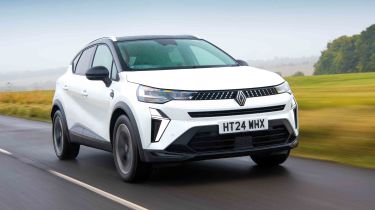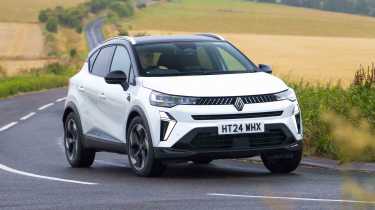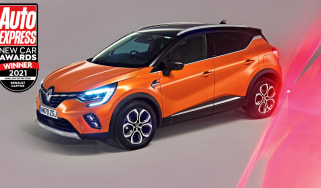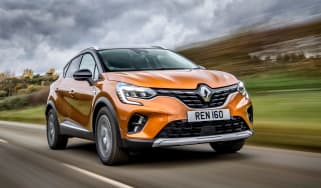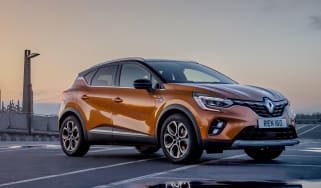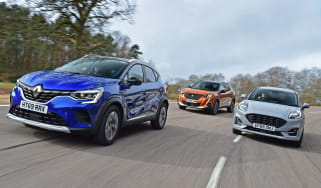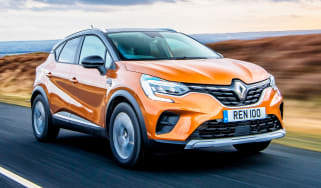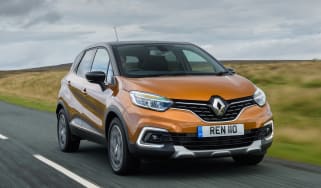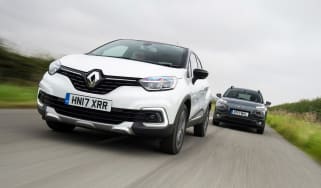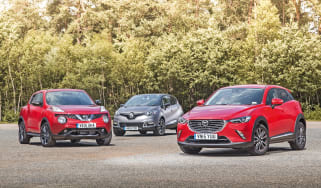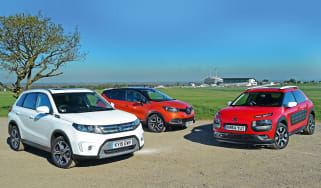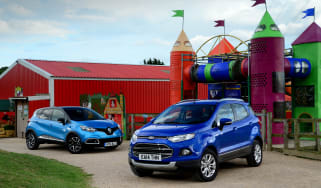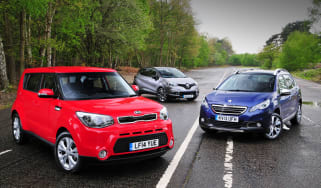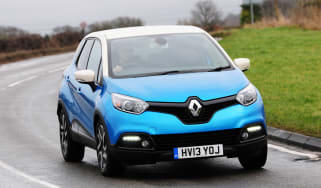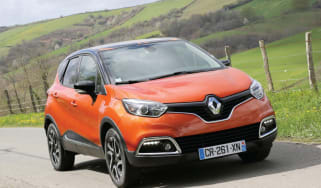Renault Captur review
Revamped looks keep this small SUV looking fresh, but its age is starting to show in places

Our opinion on the Renault Captur
Despite the Renault Captur competing in a crowded small SUV sector, it does an admirable job, thanks to attractive pricing, sleek tech, and efficient powertrains. Although it may not be the newest option in the class, valuable updates across the range have kept it competitive.
It’s not as sharp to drive as some rivals, and the cabin design is starting to look and feel a little dated, but fundamentally, this car’s focus on what its buyers will appreciate is enough to keep it at the sharp end of the class. Just be careful with higher-spec models, as the value equation starts to falter as prices rise, and the ride can become a bit choppy with the larger wheel sizes.
| Key specs | |
| Fuel type | Petrol, Petrol Hybrid |
| Body style | B-segment SUV |
| Powertrain |
1.0-litre, three-cylinder petrol, front-wheel drive 1.8-litre, four-cylinder full-hybrid, front-wheel drive |
| Safety | 4 stars (Euro NCAP, retested 2024) |
| Warranty | 3 years, unlimited mileage |
About the Renault Captur
With prices starting from around £22,500, the Renault Captur is the cheapest model in the company’s SUV line-up, which now spans six models. That also means it’s one of the better-value small SUVs currently for sale.
The UK range is simple, with two engine choices and three trim grades, which kick off with the Evolution variant. Highlights for the base model include 17-inch alloy wheels, a 10.4-inch infotainment screen with wireless Apple CarPlay and Android Auto, a seven-inch driver’s display, wireless charging, LED headlights and cruise control.
Used - available now

2019 Renault
Captur
44,897 milesManualPetrol0.9L
Cash £7,626
2022 Renault
Captur
19,338 milesManualPetrol1.0L
Cash £13,309
2017 Renault
Captur
34,559 milesManualPetrol0.9L
Cash £8,000
2019 Renault
Captur
72,300 milesManualPetrol0.9L
Cash £7,495Renault expects most UK buyers to choose the mid-range Techno, which starts from £24,000 and adds larger 18-inch wheels, built-in Google services including Google Maps for the infotainment system, a larger 10.25-inch driver’s display, ambient lighting and a modular boot floor. Every trim level is available with a petrol or hybrid powertrain, with the latter commanding a premium of around £3,000.
At the top of the range is the near-£29k Esprit Alpine, which is only available with the hybrid powertrain. It adds 19-inch alloys, adaptive cruise control, electrically adjustable and heated front seats, a heated steering wheel, and a unique interior combination of synthetic leather and fabric trim.
The Esprit Alpine also features a range of outside styling enhancements, including a dual-tone paint finish, Alpine badging, and dark grey exterior trim elements.
If you're considering a Renault Captur of your very own, be sure to use our Find a Car service. You can configure your ideal Renault Captur and find top deals from our dealer network, discover the very best Captur leasing deals or choose from a huge selection of top-notch used Captur models. Need to sell your car? Be sure to visit our Sell My Car page.
Performance & driving experience
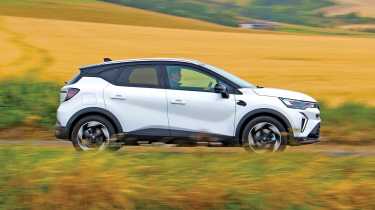
| Pros |
|
| Cons |
|
Comfort is the Captur’s calling card, with the French model delivering a smoother ride than most alternatives in this class. We think that the entry-level 89bhp petrol engine could do with a little more power, though.
Performance, 0-60mph acceleration and top speed
High performance is rarely a top priority in this class, but the entry-level 1.0-litre TCe powertrain in the Renault Captur is, without sugar-coating it, slow. With the engine packing a peak power output of only 89bhp, and a lean 160Nm of torque, acceleration is leisurely beyond the sluggish on-paper 0-62mph time of 14.0 seconds.
Being a little undernourished, the engine needs to work quite hard to keep up with traffic at high speeds, affecting refinement and economy. The six-speed manual gearbox shifts well, which is good news because you’ll need to use it frequently to make good progress. The Captur E-Tech largely fixes all these issues, but for a not inconsiderable £3,500 extra.
Originally, this model was fitted with a 1.6-litre powertrain producing 143bhp. However, this has since been upsized to a 1.8-litre that churns out 158bhp. While we’re yet to try out this updated powertrain in the Captur, it’s the same setup that’s found within the Dacia Bigster. What we know from driving the Bigster hybrid is that while performance isn’t exactly punchy, power delivery is nice and smooth.
The newer 1.8-litre hybrid also cycles quite keenly between pure-electric, hybrid and petrol drive modes, so the engine note doesn't always coincide with accelerator input. While this is a bit disconcerting at first, it doesn’t affect power delivery.
Town driving, visibility and parking
If you opt for hybrid power, the Captur spends most of its time in electric mode at lower speeds, making it very smooth and quiet when shuffling about in traffic.
However, the base petrol model is hampered by a spongy clutch pedal, which makes the same low-speed journey less pleasant. It’s one of our few criticisms, though, because otherwise, the Captur’s decent visibility, light steering, and soft ride make it a really pleasing place to be during the slowest, most boring parts of urban trips.
B-road driving and handling
The soft suspension of the Renault Captur can take more than one bounce to settle if you hit a larger bump, but it generally delivers impressive comfort on the move. You’ll also notice a reasonable amount of body lean in the bends – a feeling that is enhanced by what seems like an SUV-like high centre of gravity – compared with the more agile Ford Puma, but you can still confidently maintain a very satisfying flow along a twisty road in the Captur because there’s plenty of outright grip on offer.
Motorway driving and long-distance comfort
At higher speed, the Captur Hybrid easily has what it takes to keep up with traffic. The base petrol model feels much more strained, though, and you really need to use the full travel of that accelerator pedal to make decent progress. Once up to speed, both are impressively comfortable and refined, but we’d like slightly more precise steering to give an added feeling of stability.
| Model | Power | 0-60mph | Top speed |
| TCe 90 | 89bhp | 14.3s | 104mph |
| E-Tech 160 | 158bhp | 8.9s | 106mph |
“The Ford Puma is great fun on a twisty road, but the Renault Captur soaks up bumps better and has less road noise at higher speeds.” - Alex Ingram, chief reviewer.
MPG & running costs
| Pros |
|
| Cons |
|
Whichever powertrain you choose, the Renault Captur is unlikely to break the bank. The range starts from under £22,500, which places it among the cheapest cars in the segment, while certain PCP finance deals can be paired with zero per cent APR to minimise the monthly payments.
Officially, the petrol model achieves up to 47.9mpg on the combined WTLP cycle, but fuel efficiency is what the hybrid model does best. Renault says it’ll return 65.7mpg. The older 1.6-litre hybrid also claimed a respectable figure of 60.1mpg, and while we didn’t quite match that figure when we ran a Captur on our long-term test fleet, we achieved 53.2mpg over the course of six months and 9,000 miles of driving, with plenty of those journeys covered on motorways.
When you’re in town, the Captur’s ability to remain in full-electric mode means that the official figure should come within close reach.
| Model | MPG | CO2 | Insurance group |
| TCe 90 | 47.9mpg | 134g/km | 11E |
| E-Tech 160 | 65.7mpg | 97g/km | 16E |
Insurance groups
Depending on powertrain and trim, the Captur’s insurance groups range from 11 to 16. In comparison, the Ford Puma resides between groups 12 and 21, while the Dacia Duster occupies groups 17 to 24.
Tax
As hybrids no longer qualify for discounts, both versions of the Captur are liable for the standard VED road tax charge. While fully electric vehicles are significantly cheaper for company car users to run, the Captur E-Tech’s CO2 emissions of 97g/km do at least help it to undercut many other petrol and hybrid cars in its class.
Depreciation
The second-generation Renault Captur is a respectable performer in terms of residual values. Data from our experts suggests that it will retain between 52 and 54 per cent of its original list price over three years and 36,000 miles, depending on the chosen powertrain and trim. The 1.0 TCe 90 Evolution model is the best performer, and should retain around 54 per cent.
To get an accurate valuation for a specific model, check out our free car valuation tool...
Interior, design & technology
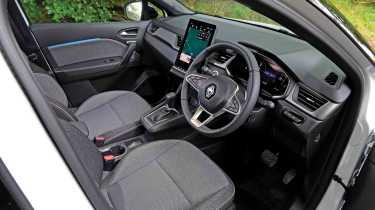
| Pros |
|
| Cons |
|
The Renault Captur received a substantial facelift in 2024, applying the brand’s new design language to the existing model with varying levels of success. The biggest difference is to be found up front, where the complex and curvy headlights have been replaced with more angular LED headlights that create a more distinct brow.
This is matched with a graduated grille pattern and the latest Renault logo, both of which do a good job of keeping the overall design looking sharp. These big changes are not reflected along the sides or at the rear, which are a little softer and less chiselled.
Renault offers two general styling themes: the base car features lots of body-coloured elements for a cleaner look and either 17- or 18-inch wheels, while the top-of-the-range Esprit Alpine uses the Alpine brand’s sportier styling elements that include grey accents up front, a dual-tone roof with contrasting silver roof rails, and wheels that are upsized to 19-inches.
Renault has included generous levels of standard kit: all cars come with alloy wheels, LED headlights, auto folding electrically adjustable mirrors, rear privacy glass, automatic air conditioning and a host of active safety systems such as lane-keeping Assist and traffic sign recognition.
Interior and dashboard design
The dashboard has been gently revised for the facelifted model, and the old car’s large rotary dials for the climate control have sadly been dropped. However, the good news is that, unlike some rivals, actual buttons remain, although the bank of rocker switches are more fiddly to use than the old layout.
The flip side of this is that an additional storage shelf has been freed up just beneath the main touchscreen. A floating centre console brings both the stubby gear selector and smartphone shelf with its USB ports (and wireless charging on range-topping trims) close to the front seats.
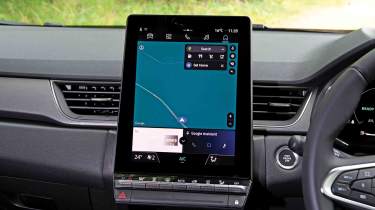
Materials and build quality
Supermini-based SUVs commonly feature lots of hard, scratchy plastics in order to reduce costs, and while the Captur is no different, most of the cheap-feeling materials tend to be low down on the door trims and centre console.
The elements used higher up have an air of quality that’s above average for the class, while fabric-trimmed panels and coloured plastics on the dashboard help to break up what would otherwise be a fairly grey and monotonous cabin. Other details, such as the razor-sharp resolution of the digital driver’s display, help add to the Renault’s overall feel-good factor.
Infotainment, sat-nav and stereo
Unlike the previous Captur, all trim levels come equipped with the full-size 10.4-inch touchscreen infotainment system. A rear-view camera and cruise control are also fitted as standard, while the top-spec Esprit Alpine cars add adaptive cruise control, an electrically adjustable driver’s seat, plus heating for the front seats and steering wheel.
Renault’s OpenR Link infotainment system used in the Captur features an Android operating system, which was first introduced in the Megane E-Tech. Choose Techno trim or above, and it includes built-in Google Maps, which looks fantastic on the screen, responds to inputs and loads menus very quickly, and is easy to use. It’s so good that there’s little reason to connect your phone to use a navigation app to find your way around and avoid traffic jams.
A shortcut bar is integrated into the top of the display, so it’s always easy to navigate the intuitive system.
“The top-spec Esprit Alpine features a leather substitute that feels just like the real thing, while the seats themselves are comfortable and supportive. Overall quality inside is great, especially when you consider the Captur’s competitive pricing.” - Dean Gibson, senior test editor.
Boot space & practicality
| Pros |
|
| Cons |
|
The second-generation Captur sits on the same CMF-B platform as the latest Renault Clio, and it’s 110mm longer, 19mm wider and 17mm taller than the original model. The new platform and bigger dimensions have brought gains in passenger space and practicality, helping the Captur attract customers with growing families. Usefully, each door can take a 1.5-litre water bottle, and there’s good storage for cups and phones – including a wireless charging plate.
Access for passengers at the rear is good, and noticeably better than the Peugeot 2008, which has a lower roofline. The rear seats in the Captur are also more comfortable than those in the Ford Puma where you have to sit higher up with your legs tucked back.
| Dimensions | |
| Length | 4,239mm |
| Width | 1,797mm (2,004mm inc mirrors) |
| Height | 1,575mm |
| Number of seats | 5 |
| Boot space | 422-1,276mm (petrol), 326-1,276mm (E-Tech hybrid) |
Dimensions and size
The overall length of the Captur has increased to 4,239mm, with a width of 1,797mm (excluding mirrors) and a height of 1,575mm. In comparison, the Ford Puma is 20mm shorter, 8mm wider and stands 1,537mm tall, while the Peugeot 2008 is 4,300mm long, 1,770mm wide, and 1,550mm in height.
Driving position, seats & space in the front
There’s plenty of adjustment in both the driver’s seat and steering wheel, giving lots of scope for getting comfortable in what is quite a lofty seating position for a small SUV. However, storage is a bit of a mixed bag, with the raised centre console opening up space for a large storage area below, including a pair of cup-holders. However, the glovebox capacity is impacted by the fuse box, and the door bins are fairly slim.
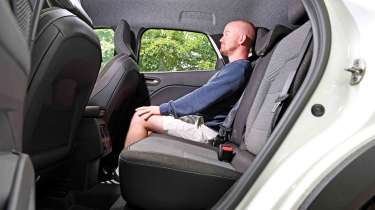
Seats & space in the back
Interior space is excellent for passengers, with lots of headroom backed up by above average kneeroom for the segment. There’s more space to stretch your legs out here than in a Jeep Avenger or a Nissan Juke, if not quite as much as in a Skoda Kamiq or a Dacia Duster. Foot room is also excellent under the front seats.
Unusually in this class, the Captur comes with a sliding rear bench. It offers benefits for boot space, but with it moved all the way forward, it all but completely eliminates rear kneeroom. ISOFIX points are hidden behind zips, which makes them a bit fiddly to access.
Boot space
The 422-litre luggage area is reasonably sized, if not class-leading, but the sliding rear seat bench sets it apart from rivals. Move it all the way forward, and the total volume grows to a huge 536 litres, but that renders the back seats pretty much useless for anyone but very young children.
That boot space benefits from plenty of under-floor storage, but it’s a slightly uneven shape. The load lip is also quite high, which makes lifting heavier items on board a bit more difficult than in some rivals.
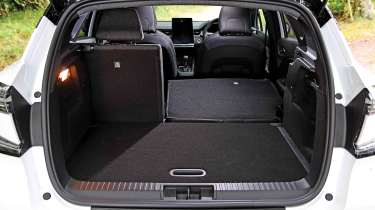
Towing
Both the TCe 90 has a maximum braked towing weight of 1,200kg, while the newer 1.8-litre hybrid has a rating of 1,000kg.
“Cabin storage is decent up front, but given that the Captur’s dimensions are largely unchanged from the outgoing car’s, space in the rear remains a little compromised.” - Dean Gibson, senior road test editor.
Reliability & safety
| Pros |
|
| Cons |
|
Renault finished in a disappointing 28th place out of 32 manufacturers in the most recent Driver Power best manufacturer rankings. Owners appreciated the brand’s low running costs but weren’t fans of its powertrain smoothness and performance.
Euro NCAP was much more appreciative of the Captur, however, awarding it a maximum five-star safety rating when the French model was tested in 2019. However, it has been re-assessed in 2024 alongside the Renault Symbioz, which shares parts in common with the Captur.
The test has become tougher since the Captur was first tested in 2019, and due to it not including such features as a child presence detection system, a warning to prevent you from opening the doors into the path of approaching vehicles (such as cyclists), a central airbag to stop the front seat occupants from hitting each other in a side collision, and having poor chest protection for the driver in the front impact, its previous five-star score has been adjusted to four stars. That’s still better than the three-star result of the Dacia Duster, but behind the highest five-star rating of the admittedly pricier Toyota C-HR.
There’s still a raft of driver assistance systems as standard on the Captur, from a tyre pressure warning light, an Active Emergency Braking System, Traffic Sign Recognition, cruise control with a speed limiter, Hill Start Assist, a distance warning alert, automatic headlights and windscreen wipers, Lane Departure Warning, Lane Keep Assist and E-Call: a system that allows the emergency services to be called automatically or manually in the event of a collision.
| Key standard safety features |
|
| Euro NCAP safety ratings |
|
Buying and owning
Our best buy: Renault Captur Hybrid E-Tech Techno 180
It’s not the cheapest model in the line-up, but opting for Techno trim adds a very pleasant helping of goodies to this small SUV. A larger 10.25-inch driver’s display, a false boot floor and ambient lighting make the Captur feel just a bit more luxurious without making a huge dent in your finances.
While the TCe 90 petrol engine isn’t terrible, it doesn’t offer the outright power and efficiency of the E-Tech 180 hybrid. This does cost a bit more to buy, but you should see some savings when it comes to running costs.
Renault Captur alternatives
Renault is one of a number of manufacturers battling for sales in the small SUV class. There’s the premium and tech-laden Peugeot 2008, the fun-handling Ford Puma, and three VW Group rivals in the shape of the Skoda Kamiq, SEAT Arona and Volkswagen T-Cross.
There’s also the left-field Fiat 600 and the closely related Jeep Avenger, along with a range of Japanese alternatives, including the Nissan Juke (which shares the same platform with the Captur), Toyota Yaris Cross, Honda HR-V, not forgetting tech-forward Hyundai Kona and Kia Niro options from South Korea.
Latest deals on the Captur and rivals
Renault Captur history
Renault Captur Mk1: 2013-2019
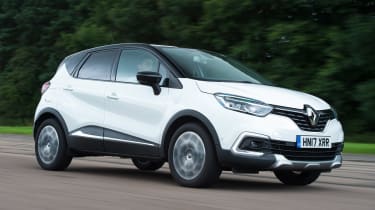
As one of the first entrants in the small SUV segment back in 2013, the Renault Captur was quick to find an audience looking for a supermini footprint combined with the added practicality and versatility of an SUV. Today, all of Renault’s key rivals have an offering of this size, creating a marketplace full of competitive rivals.
The small SUV class is aimed at the growing family looking for style, space and plenty of safety kit. Renault has ticked all three boxes, but particularly the latter, as all models feature a host of equipment designed to protect the driver, passengers and pedestrians out on the road.
The 2024 facelift of the Mk2 Captur, that originally launched in 2019, introduced a new look, featuring a wider grille and LED lights at the front and rear, helping it to cut a more impressive figure on the road. Customers that wish to really stand out from the crowd are well catered for, too, with a choice of six exterior body colours with or without a contrasting black roof.
Renault Captur pictures
Frequently Asked Questions
The Captur has a fairly standard three-year/60,000-mile warranty, which is slightly shorter than the 3yr/100,000-mile cover for Renault’s EVs. The mileage limit for the Captur is unlimited in the first two years, though.
New & used Renault Captur deals
